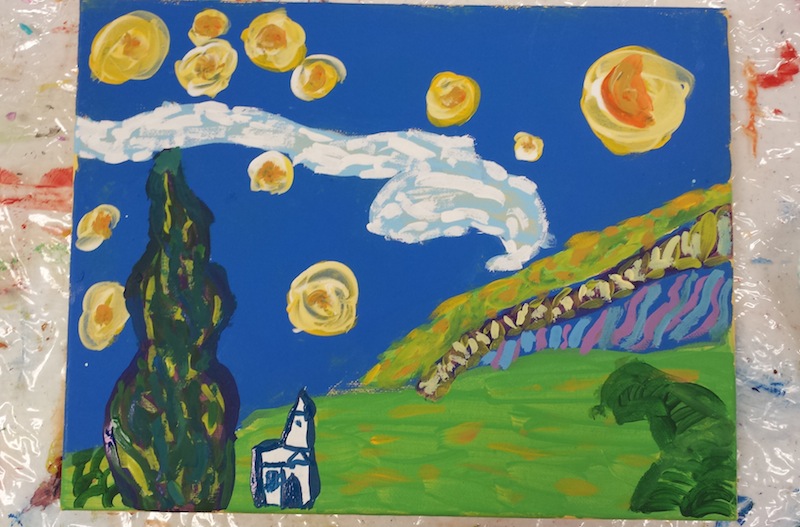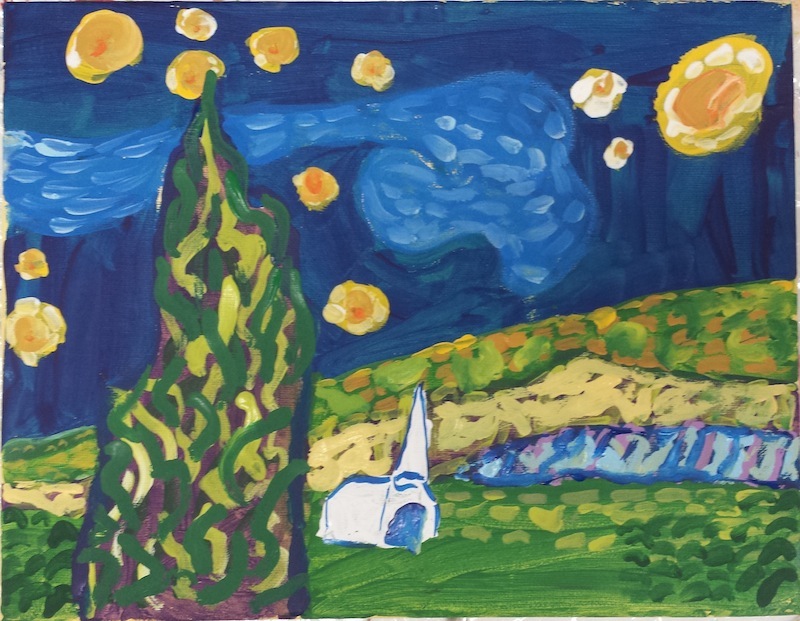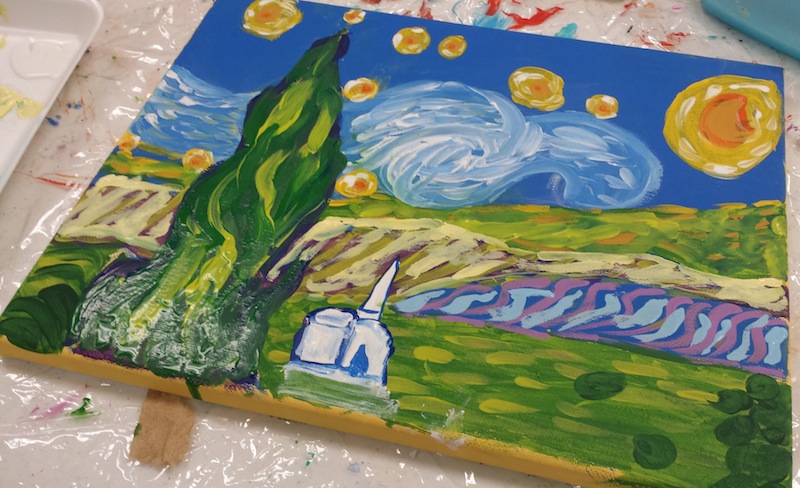Starry Night: Art Lesson for Kids
 Vincent Van Gogh is my favorite artist. His work is full of expression, color and movement. I smile every time I look at his bright and cheery paintings.
Vincent Van Gogh is my favorite artist. His work is full of expression, color and movement. I smile every time I look at his bright and cheery paintings.
Starry Night is on the top of my list of Van Gogh’s works. I can see why it is one of the most sought after prints in the world. So amazing since Van Gogh only sold “one” painting in his lifetime. What a great reminder for us artists to just enjoy the gift of creating—you never know (something you make may positively impact another person (the world!!!). 🙂
Before we get started, take a look at this excellent video that shows the movement and flow of Starry Night: vimeo-Starry Night (Interactive).
This lesson for the kids in my 1st – 3rd grade art class is such a great piece to paint to show children flow, rhythm, movement, texture, pattern, shape and color. Plus, they learn about composition (the placement/how items are arranged in a painting) when they reproduce a work of art.
Since I had 20 children to work with, I forgot to take pictures of the process. I will do my best to explain what we did to get our finished masterpieces of Starry Night.
SUPPLIES:
Tablecloth or placemat to go under canvas
Canvas (11×14)
Liquid acrylic paint in various colors
White chalk
Paintbrushes
Paint trays
Water (clean brushes)
LESSON:
While the children painted their entire 11×14 canvas with a thin coat of golden yellow, I explained to them that this is what is known as ground color.
I did this for two reasons. Mostly, so we could use white chalk to layout the design of Starry Night. The other reason was so the yellow background color would show through if the children missed a spot while painting in all the elements of the design.
In order to help the children learn where to place everything (composition) on the canvas, I first divided my finished painting of Starry Night into quadrants (a chalk line through the middle vertically (top to bottom) and horizontally (left to right)). I briefly discussed how each element (the stars, moon, clouds, tree, mountains and church) lives in a certain quadrant.
NOTE: Even with dividing the canvas up in four equal parts, it’s very easy for small children to get confused with left and right placement of things. Especially in a class setting with another student sitting across from them painting a mirror image of what they are painting. Therefore, another reason I use chalk when working with children and I take time to help each student understand where to place each element.
 After chalking in where everything lived, we painted our canvas from background to foreground. The sky was painted first in a dark blue. The clouds were added in light blue with small strokes of white. The stars were painted as circles (various sizes) in yellow and then the children went around the yellow circles adding white strokes of color. A dot of orange was added to the middle of each star and also used to paint the moon. NOTE: I found in painting with small children, it’s best to explain things in terms they already understand. So the easiest way to help the children (5 – 7 year olds) paint a moon was to tell them to paint the letter “C”.
After chalking in where everything lived, we painted our canvas from background to foreground. The sky was painted first in a dark blue. The clouds were added in light blue with small strokes of white. The stars were painted as circles (various sizes) in yellow and then the children went around the yellow circles adding white strokes of color. A dot of orange was added to the middle of each star and also used to paint the moon. NOTE: I found in painting with small children, it’s best to explain things in terms they already understand. So the easiest way to help the children (5 – 7 year olds) paint a moon was to tell them to paint the letter “C”.
After we painted in our sky, we painted in our three mountains (that we chalked in).
We painted our ground green and added a few curved lines in dark green to represent hay bales.
Before painting the tall tree, we talked about curved lines and how the tree looks like a flame a fire. They used the sky dark blue, dark green and light green to paint their tree.
The church was added last using basic shapes of squares and a triangle. They painted it white and then outlined it in the color of the sky and added the door.
I love how the children captured the dimension of the front and side view of the church.
So fun!!! Are you smiling? I hope you enjoyed these as much as I did. 🙂
♥ Michelle
Find Happy Heart: Fill’er Up!
Follow on Twitter
Join the fun on Pinterest
Check out what’s on Facebook
Connect with me on LinkedIn
Signup for Blog, Announcements & Updates (in Column)







05/08/2015 @ 9:03 am
Lucky are the children “under your brush”
05/11/2015 @ 11:57 am
Thank you Susan…it has been a blessing…so fun to teach these enthusiastic little painters!!! 🙂
05/10/2015 @ 6:08 pm
These are gorgeous, Michelle. This is Tommy’s favorite painting, too! I love them!!! You are such an awesome teacher.
05/11/2015 @ 11:55 am
Thank you Renee! We had fun & they worked hard slinging paint to finish these masterpieces in just three classes!!!! 🙂
02/17/2016 @ 4:29 pm
I’ve always wished I was a better artist. I’m a musician and can totally rock anything on the piano, but painting and drawing stymie me. In fact, I did a workshop with a lady at church who was an artist. She had everyone paint a daffodil. She took a strange look at mine and pronounced it “abstract.” I had a really good laugh about that! My children can paint beautifully, though. I appreciate this lesson!
02/18/2016 @ 3:20 pm
Thank you so much for stopping by Kathryn…and for your kind remarks!!! Thanks for sharing your painting story…I love it! 🙂
I have taught a few classes and even though the class is painting the same thing, they all turn out so different. This is one of my favorite things about it! 🙂 Anyway, I am always in awe of anyone with musical abilities…I’m all abstract with this one!
02/19/2016 @ 8:48 am
Michelle, how awesome are those paintings!!! What fun you all must have in class!!
02/19/2016 @ 9:10 am
Thank you Keri! Teaching little ones is always such a blessing…they eager learners and make the cutest paintings!!! 🙂
02/22/2016 @ 4:27 pm
I love “Starry Night” it’s a gorgeous painting and it’s so cool that you used this classic to teach children to paint. I love how you deciphered art to teach in a way that the children would be able to understand and comprehend. I love the pictures that they’ve created! So cool. I would not have ever thought of the quadrants, it’s brilliant!
02/22/2016 @ 4:32 pm
Thank you so much Nikki…you always make me smile!!! Love seeing what little ones create…their art is so fresh and fun!!!